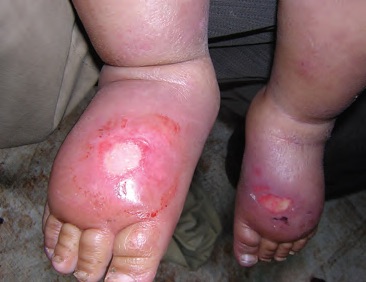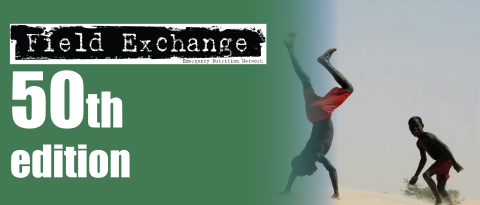New implications for controversial kwashiorkor treatment discussed in Paediatrics and International Child Health
Summary of research1
The latest issue of Paediatrics and International Child Health sees leading experts in the field of malnutrition address the ongoing controversy surrounding the use of albumin for treatment of oedema in children with kwashiorkor in shock.
For many years, the essential cause of oedema in kwashiorkor was considered to be low oncotic pressure owing to low plasma albumin concentration (Starling forces2). However, in 1980, this understanding was challenged by Mike Golden (University of Aberdeen), Alan Jackson (University of Southampton) and co-workers, and there has been controversy surrounding treatment of kwashiorkor ever since.
 Now, in a new article,3 Malcolm Coulthard (University of Newcastle, UK), re-analyses Golden et al.’s data and demonstrates that there is a significant association between low plasma albumin concentration and oedema in kwashiorkor, and that loss of oedema is associated with a rise in albumin concentration. On the back of his findings, and based on his experience of managing crises in children with congenital nephrotic syndrome, he proposes a trial of IV albumin for children with kwashiorkor who are in shock.
Now, in a new article,3 Malcolm Coulthard (University of Newcastle, UK), re-analyses Golden et al.’s data and demonstrates that there is a significant association between low plasma albumin concentration and oedema in kwashiorkor, and that loss of oedema is associated with a rise in albumin concentration. On the back of his findings, and based on his experience of managing crises in children with congenital nephrotic syndrome, he proposes a trial of IV albumin for children with kwashiorkor who are in shock.
Michael Golden has responded with an exhaustive review4 of the literature on oedema and a re-evaluation of a wide variety of conditions manifesting with oedema in children and adults, concluding that in light of present knowledge, each condition has enough anomalous characteristics such that Starling forces alone no longer explain the cause of oedema. In summary, he concludes that the child with kwashiorkor is physiologically different from the child with nephrotic syndrome and that the proposed treatment is “fraught with danger”.
The third paper in the series, a commentary5 by Alan Jackson, reviews both of these articles and traces the development of the management of kwashiorkor since the 1980s, particularly in relation to the role of dietary protein and systematic trials of volume and/or albumin replacement therapy. Both Golden and Jackson caution against the use of IV albumin in the management of kwashiorkor in general. Coulthard, in a Letter to the Editor,6 acknowledges the lack of evidence of the value of IV albumin and the potential dangers of its use, but argues that, given the lack of appropriate guidelines, a carefully controlled randomised trial of IV albumin is justified.
Together, these three papers address the controversy around the treatment of kwashiorkor and stimulate further discussion and research in the area. Brian Coulter, the journal’s Editor-in-Chief, comments: “These articles provide an excellent update on the pathophysiology and management of oedematous malnutrition. Despite a WHO review of the management of severe malnutrition in children in 2013, treatment of those with intravascular depletion, particularly patients with kwashiorkor in shock, remains unsolved.”
All three articles, published in Paediatrics & International Child Health, are free to access here.
Footnotes
1http://www.maneyonline.com/toc/pch/35/2
2 The low oncotic pressure caused by hypoalbuminaemia induces hypovolaemia, which triggers salt and water retention.
3Malcolm Coulthard (2015). Oedema in kwashiorkor is caused by hypoalbuminaemia. Paediatrics and International Child Health 2015 Volume 35, Issue 2 (May 2015), pp83-89
4Michael H Golden (2015). Nutritional and other types of oedema, albumin, complex carbohydrates and the interstitium – a response to Malcolm Coulthard's hypothesis: Oedema in kwashiorkor is caused by hypo-albuminaemia. Paediatrics and International Child Health. Volume 35, Issue 2 (May 2015), pp. 90-109
5Alan A Jackson (2015). Albumin in nephrotic syndrome and oedematous malnutrition. Paediatrics and International Child Health. Volume 35, Issue 2 (May 2015), pp. 77-80
6Malcolm Coulthard (2015). Letter to the editor. Paediatrics and International Child Health. Volume 35, Issue 2 (May 2015), pp. 164-164


